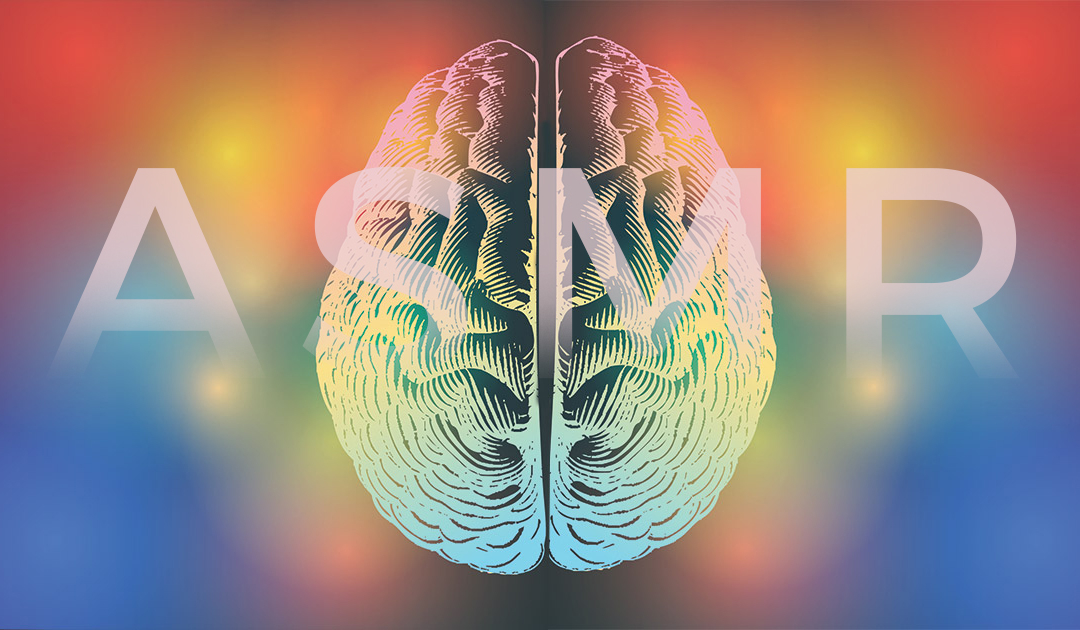What Is ASMR?
While studying up on techniques to woodchuck-proof my vegetable garden, I recently came across a viral YouTube video of a (admittedly cute) woodchuck eating away at a hapless gardener’s veggies. The viewers’ comments caught my eye because of their frequent mention of the woodchuck’s “ASMR impact.” Not being internet savvy enough to recognize that acronym, I turned to Google to find out that it stands for “autonomous sensory meridian response.” This impressive sounding phrase turned out to be a recently-coined term for the experience many people have when viewing something comforting, or while listening to relaxing sounds like rustling, whispering or gentle tapping, or when watching scenes of nature. It’s the pleasant tingle that starts at the top of the head and flows down the back of the spine, euphoric but non-sexual, leaving one feeling relaxed and at peace.
The phenomenon was first described 10 years ago by a blogger who purposely chose neutral and objective terms to describe this highly subjective experience, but there was no scientific basis for her creatively technical terminology. As a biofield researcher, the word “meridian” caught my eye, but it was chosen to refer to the peak or point of highest development of the sensation rather than to any particular acupuncture pathways. Still, I wondered what the subtle energy aspects of this strong sensation might be.
Neuroscience’s Explanation
ASMR has developed a huge online presence, with scores of forums and Facebook groups and websites, thousands of YouTube videos designed to stimulate ASMR (and tens of millions of viewers), an online “University,” and more. This wave of interest has generated a fair amount of recent neuroscience research, finding strong correlations of ASMR with such physiologic parameters (Poerio 2018) as heart rate variability, increased default mode neural network functioning (Smith et al 2017), and decreased functional connectivity in certain brain regions. Further research from a cognitive neuroscience perspective is developing a model of ASMR’s brain mechanisms, while potential clinical applications are being demonstrated for symptoms like anxiety and insomnia (Cline 2018).
The Energetics of ASMR
But this work overlooks the most striking aspect of ASMR – its palpable energetic quality, the feeling that some internal force is flowing through the body. The energy medicine (EM) perspective on these subjective sensations has much to tell us about the underlying energy dynamics of the process and about the energy/physiology interface that underlies all EM techniques. As the emerging discipline of micro-phenomenology is discovering (Petitmengin et al 2019), a systematic study of the subjective experiences of interoceptive practices like meditation and yoga can aid our understanding of the physiologic impact of these practices. When these subjective descriptions are combined with insights from subtle energy paradigms, a new level of understanding emerges. So, here’s an EM perspective on ASMR.
Subtle Anatomy and Sensing Energy
In brief, a subtle anatomy of invisible healing energies has been described in many cultures and therapies. The main components are the biofield (the aura), the transmission pathways (the acupuncture meridians), and the centers of emotional charge (the chakras). Several researchers have noted that distinctive subjective experiences accompany the activation of each of these centers (Judith 2018; Leskowitz 2020). As seen in Figure 1, each of the centers is associated with a unique felt sense that accompanies its activation, as well as a common figure of speech to describe the experience.
| CHAKRA | ENDOCRINE GLAND | EMOTION | SENSATION | |
| 7 | crown | pineal | bliss | scalp tingling |
| 6 | brow | pituitary | intuition | inner “light bulb” |
| 5 | throat | thyroid | creativity | “choked up” |
| 4 | heart | thymus | love | “warm-hearted” glow |
| 3 | solar plexus | pancreas | power | “butterflies” |
| 2 | sacral | gonads | sexuality | “turned on” |
| 1 | root | adrenal | fear | adrenaline “rush” |
Figure 1 – Chakra energy sensations
]But can we really feel our chakras? In this multi-dimensional model of human functioning, physical sensations are the densest level of human experience. The next level up in subtlety are the energy “tinglings” of Figure 1, the palpable flows of prana/qi/etheric energy, followed by the emotional charge that activates this energy flow, and then above that the thoughts and beliefs that set up the perceptions and responses in the first place. These levels correspond to the yogic model of energy bodies or sheaths (koshas), and to the Theosophic model of planes of consciousness: physical, etheric, astral, mental and causal/transpersonal. Strong emotions can thus generate an energetic charge that is intense enough to be felt by untrained lay people.
Assessing Energy Dynamics
So, what is happening with ASMR? To answer this question, there are three primary methods to help us determine which elements of our subtle anatomy are involved: introspection, clairvoyant perception, and direct measurement.
Introspection: Of note, the scalp-tingling feeling of deep relaxation begins at the crown chakra. Mystic traditions assert that crown openings are triggered by experiencing connection to something greater than the self. In other words, it’s a transpersonal or spiritual experience. Feeling comforted by a loved one, being surrounded by nature – these experiences do just that, as they take us beyond our limited sense of self to an expanded sense of self.
The subsequent flow of warmth down the back of the neck and the spine may be a true “meridian” experience in the acupuncture sense, because the Governing Vessel meridian of Traditional Chinese Medicine (TCM) starts at the crown point and runs down the back side of the spine. For example, in the qi gong practice called the Microcosmic Orbit, the energy flow is directed along this path, though in an upwards direction. In ASMR, the chakra/meridian link may be the key to its whole-body impact.
Clairvoyance: Observation by a Clairvoyant
(Hemsher 2020) reveals that the sensation arises from a combination of astral and etheric energies. The astral energy is felt emotionally, as “a rich sense of the sheer preciousness of life, peace and delight.” The etheric energy is felt as the more physical “sensation of pleasure, soothing and calming.” The ASMR is a “kind of tickle of energy in the back of the crown, which may be the governor meridian in that space, and flows down the governor meridian” (chakras and meridians operate at slightly different energetic frequencies, in what have been called the sub-planes of the etheric body [Friedlander & Hemsher 2012]).
Devices: And finally, several reliable techniques and devices could be utilized to detect the flow of subtle energy during ASMR (Muehsam et al 2015). For example, it would be possible to determine whether the Governing Vessel meridian is in fact activated during ASMR, either by using TCM’s pulse diagnosis to assess meridian activity or by the use of the AMI device (the Apparatus for Meridian Identification of Motoyama, which measures electrical conductivity at the fingertip endpoints of the major meridians, as a surrogate for actual qi flow). The embodied sense of warmth and comfort might be accompanied by an increased release of biophotons, readily detectable with sensitive photomultipliers. Other devices (magnetometers, Kirlian photography) could measure electromagnetic fields and related phenomena.
Future Directions
In summary, it seems that ASMR is a very common but only recently-described subtle energy process that begs for further exploration beyond the neuroscience dimension. Input from the realms of phenomenology, clairvoyant perception and biomedical instrumentation can help us to better understand this omnipresent and intriguing phenomenon. In the same way, other energy-related phenomena could also be explored with this three-pronged approach to research. It’s a spine-tingling prospect to consider!
References
Barratt EL, Davis NJ. 2015. Autonomous Sensory Meridian Response (ASMR): a flow-like mental state. PeerJ, 3:e851. doi.org/10.7717/peerj.851
Cline J. What is ASMR, and why are people watching those videos? Psychology Today, Sept. 26, 2018. https://www.psychologytoday.com/us/blog/sleepless-in-america/201809/what-is-asmr-and-why-are-people-watching-these-videos
Interview with Jennifer Allen, ASMR University, May 17, 2016. https://asmruniversity.com/2016/05/17/jennifer-allen-interview-coined-asmr/
Fredborg B, Clark J Smith S. An examination of personality traits associated with Autonomous Sensory Meridian Response, Frontiers in Psychology, 23 February 2017. https://doi.org/10.3389/fpsyg.2017.00247
Friedlander, J, Hemsher, G., Basic Psychic Development: A User’s Guide to Auras, Chakras and Clairvoyance, Weiser Books, 2012.
Hemsher, G, personal communication, July 30, 2020.
Judith, A. Charge and the Energy Body: The Vital Key to Healing Your Life. Hay House, 2018.
Leskowitz, E. A cartography of energy medicine: From subtle anatomy to energy physiology. Explore (NY). 2020 Sep 25:S1550-8307(20)30308-6.
Muehsam, D, Chevalier G, Barsotti T, Gurfein B. An overview of biofield devices. Global Advances in Health and Medicine, 4(Supplement):42-51, 2015. DOI: 10.7453/gahmj.2015.022.suppl.
Petitmengin, C, van Beek, M, Bitbo,l M, et al. Studying the experience of meditation through micro-phenomenology. Current Opinion in Psychology, 28:54-59, 2019. doi.org/10.1016/j.copsyc.2018.10.009
Poerio, G. More than a feeling: Autonomous sensory meridian response (ASMR) is characterized by reliable changes in affect and physiology. PLoS One. 2018; 13(6): e0196645. Published online 2018 Jun 20. DOI: 10.1371/journal.pone.0196645
Smith, S, Fredborg, B, Kornelsen, J. (2017) An examination of the default mode network in individuals with autonomous sensory meridian response (ASMR), Social Neuroscience, 12:4, 361-365. DOI: 10.1080/17470919.2016.1188851
Related articles by the author can be found at: https://www.researchgate.net/profile/Eric_Leskowitz/publications
Learn More About the Author

Eric Leskowitz, MD
Eric Leskowitz, MD is a board certified psychiatrist with the Pain Management Program at Spaulding Rehabilitation Hospital in Boston. He has an appointment with the Department of Psychiatry of Harvard Medical School, directs the hospital’s Integrative Medicine Task Force, and has organized several conferences on the topic of Complementary and Alternative Medicine in Rehabilitation. He edited a recent text of the same name (Churchill Livingstone, 2003), and has written and lectured widely on the field of energy medicine.


I truly appreciate this unique energetic perspective from Dr. Leskowitz. Thank you for this insightful article on ASMR. I remember stating in a lecture I gave on Energy Medicine and Acupuncture, “it is difficult to explain these subtle energy forces that affect us physiologically to Western physicians because we can only measure indirect changes as of YET.” I am hopeful for future technological advancements. Functional MRI has already raised the bar on future acupuncture research.
Thanks for you kind words, Dr. Chin. I hope you’re able to pursue the kind of acupuncture research you’ve hinted at here. Keep us posted!
ASMR (or something like it) happens regularly when I practice qi gong. I began 4 years ago, self-teaching from books, YouTube, and email exchanges with teachers. Currently my routine includes ba duan jin, tai chi, and zhan zhuang – about an hour scattered over the course of the day.
Zhan zhuang usually produces a buzzing sensation in the back of my head, which often spills down into my back. Also happens with tai chi but not so much. During tai chi there can be a surge of energy into the palms or soles, always bilateral, which is rare during zhan zhuang. The head buzz can happen any time day or night, sometimes at will – if I am relaxed.
My practice is nonobjective. Initially it was for health and fitness but it has become, ineffably, something much more, which I need not analyze or speculate about.
What led to the coining of the term “meridian” in describing this subjective experience, and how does it relate to the peak or point of highest development of the sensation rather than acupuncture pathways? As a biofield researcher, what aspects of subtle energy were you interested in exploring in connection with this phenomenon?